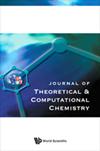4-[3-(金刚烷-1-基)-4-苯基-5-磺酰基-4,5-二氢- 1h -1,2,4-三唑-1-基]甲基哌嗪-1-羧酸乙酯的光谱和量子化学分析
IF 2.4
Q3 Computer Science
Journal of Theoretical & Computational Chemistry
Pub Date : 2019-11-04
DOI:10.1142/s0219633619500299
引用次数: 3
摘要
基于金刚烷的化合物4-[3-(金刚烷-1-基)-4-苯基-5-亚磺酰基-4,5-二氢-1H-1,2,4-三唑-1-基]甲基哌嗪-1-甲酸乙酯的傅立叶变换红外光谱和拉曼光谱分别记录在3200–650[式:见正文]厘米[式式:见文本]和3200–150[式:见图文本]厘米[式子:见文本)的范围内。标题化合物在乙醇中的溶液的UV/Vis光谱在450–200[公式:见正文]nm范围内进行测量。在理论的B3LYP/cc-pVDZ和B3LYP/cc pVTZ水平上进行DFT计算,以获得平衡几何结构并预测标题分子的振动IR和拉曼光谱。进行了该理论的CAM-B3LYP/cc-pVTZ水平的TDDFT计算,以及该理论的CASSCF(4,5)/XMCQDPT2水平的MRPT计算,以再现电子吸收光谱。根据量子化学模型的结果,对实验的红外光谱、拉曼光谱和紫外/可见光谱进行了解释。基于Mulliken和Löwdin的原子布居分析,确定所研究的化合物表现出分子内电荷转移的特征。本文章由计算机程序翻译,如有差异,请以英文原文为准。
Spectral and quantum chemical analysis of ethyl 4-[3-(adamantan-1-yl)-4-phenyl-5-sulfanylidene-4,5-dihydro-1H-1,2,4-triazole-1-yl]methylpiperazine-1-carboxylate
The Fourier transform infrared and Raman spectra of the adamantane-based compound ethyl 4-[3-(adamantan-1-yl)-4-phenyl-5-sulfanylidene-4,5-dihydro-1H-1,2,4-triazol-1-yl]methylpiperazine-1-carboxylate were recorded in the ranges of 3200–650[Formula: see text]cm[Formula: see text] and 3200–150[Formula: see text]cm[Formula: see text], respectively. The UV/Vis spectrum of solution of the title compound in ethanol was measured in the range of 450–200[Formula: see text]nm. The DFT calculations at the B3LYP/cc-pVDZ and B3LYP/cc-pVTZ levels of the theory were performed to obtain the equilibrium geometric structure and to predict vibrational IR and Raman spectra of the title molecule. The TDDFT calculations at the CAM-B3LYP/cc-pVTZ level of the theory, as well as MRPT calculations at the CASSCF(4,5)/XMCQDPT2 level of the theory were carried out to reproduce the electronic absorption spectrum. The experimental IR, Raman and UV/Vis spectra were interpreted on the basis of results of quantum chemical modeling. Based on Mulliken and Löwdin atomic population analysis, it was established that the compound under study exhibits features of an intramolecular charge transfer.
求助全文
通过发布文献求助,成功后即可免费获取论文全文。
去求助
来源期刊
CiteScore
1.70
自引率
0.00%
发文量
0
审稿时长
3 months
期刊介绍:
The Journal of Theoretical and Computational Chemistry (JTCC) is an international interdisciplinary journal aimed at providing comprehensive coverage on the latest developments and applications of research in the ever-expanding field of theoretical and computational chemistry.
JTCC publishes regular articles and reviews on new methodology, software, web server and database developments. The applications of existing theoretical and computational methods which produce significant new insights into important problems are also welcomed. Papers reporting joint computational and experimental investigations are encouraged. The journal will not consider manuscripts reporting straightforward calculations of the properties of molecules with existing software packages without addressing a significant scientific problem.
Areas covered by the journal include molecular dynamics, computer-aided molecular design, modeling effects of mutation on stability and dynamics of macromolecules, quantum mechanics, statistical mechanics and other related topics.

 求助内容:
求助内容: 应助结果提醒方式:
应助结果提醒方式:


